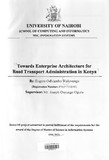| dc.description.abstract | The purpose of this research project was to establish how Enterprise Architecture can be used to
ensure that the Road Transport Department (RTD) of the Kenya Revenue Authority (KRA) derives
optimal value from IT investments. As pressure mounts on the government to provide better (faster
and more cost effective) public services, focus has turned to ICTs to enable the government to
deliver on its mandate. Attempts at automation of government services are however fraught with
failure as a result of poor requirements specifications and disjointed automation initiatives. This
research project sought to determine the extent to which Enterprise Architecture can be relied upon
to influence the successful automation of Road Transport Department services.
The Road Transport Department lacks an Enterprise Architecture and thus misses out on the
benefits offered by Enterprise Architecture. These benefits include seamless service delivery by
the department, and faster, easier and cheaper development and deployment of information
systems.
Both Primary and Secondary data were used in this study. Primary data was collected using
Interviews and Questionnaires while KRA surveys were the source for secondary data. Interviews
were conducted with select members of staff of the Road Transport Department, KRA ICT
Department, and the Directorate of e-government. Questionnaires were administered to members
of the general public seeking RTD's services. KRA surveys were provided by KRA's Research
and Corporate Planning Department.
A vast majority of RTD's customers (86%) rate service delivery by the department as either
average or poor. This indicates failure by the department to meet customer needs. Long queues,
fragmented services and poor automation were cited as the major challenges faced by customers
seeking RTD services. RTD has diverse un-integrated systems with some processes partly
automated. The systems are not secure, lack data integrity and are based on obsolete technology.
Whereas RTD management appreciates the importance of ICTs in improving service delivery,
there is a lack of understanding of what ICTs to adopt and how to do so in a systematic manner to
meet the departments business objectives.
This study shows that Enterprise Architecture is required to streamline the department's operations
and derive value for money from ICT investments. The methodology for developing an Enterprise
Architecture is defined and a sample Enterprise Architecture for the department has been
developed. The Open Group Architecture Framework (TOGAF) was the Enterprise Architecture Framework used to develop the sample Enterprise Architecture for RTD. Enterprise Architecture
should however not be regarded as a one-time event. The department needs to set up an Enterprise
Architecture function to develop and update the department's Enterprise Architecture as well as
sensitise staff on Enterprise Architecture. | en |

